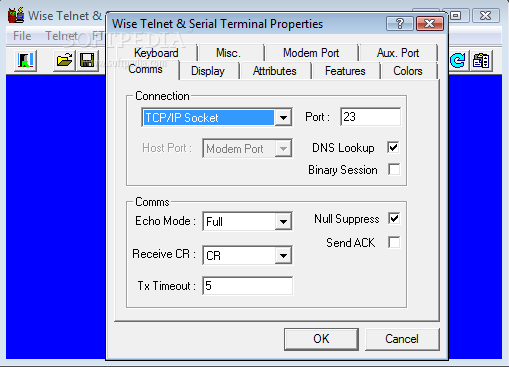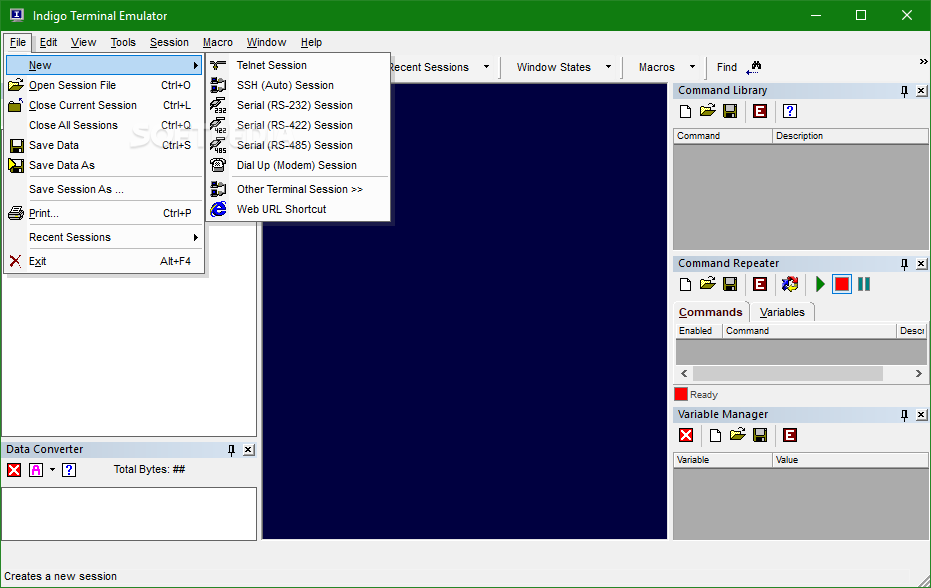Serial Terminal Emulator
This is a list of notable terminal emulators. Most used terminal emulators on Linux and Unix-like systems are GNOME Terminal on GNOME and GTK-based environments, Konsole on KDE, and xfce4-terminal on Xfce as well as xterm.
- 1Character-oriented terminal emulators
- 1.1Unix-like
- 1.1.2Graphical
- 1.1Unix-like
- 2Block-oriented terminal emulators
Character-oriented terminal emulators[edit]
Unix-like[edit]
TeraTerm – TeraTerm is an open-source terminal emulator and SSH module that supports IPv6, SSH1, SSH2, Telnet, serial ports, and file transfer protocols (XMODEM, Kermit, ZMODEM, B-PLUS, etc). Putty – Another free Telnet and SSH implementation for Windows. It also is an xterm terminal emulator. Bluetooth Serial Terminal for Windows 10 Free. You can use this App to communicate with Serial Bluetooth devices like the RN-42 that are used for arduino projects and other custom projects.
Command-line interface[edit]
- Linux console – implements a large subset of the VT102 and ECMA-48/ISO 6429/ANSI X3.64 escape sequences.

The following terminal emulators run inside of other terminals, utilizing libraries such as Curses and Termcap:
- GNU Screen – Terminal multiplexer with VT100/ANSI terminal emulation
- Minicom – text-based modem control and terminal emulation program for Unix-like operating systems
- tmux – Terminal multiplexer with a feature set similar to GNU Screen
Graphical[edit]
X/Wayland[edit]
Terminal emulators used in combination with X Window System and Wayland
- xterm – standard terminal for X11
- GNOME Terminal – default terminal for GNOME with native Wayland support
- guake – drop-down terminal for GNOME
- konsole – default terminal for KDE
- xfce4-terminal – default terminal for Xfce with drop-down support
- mrxvt – rxvt clone with additional features (latest version is 2008-09-10)
- Terminology – enhanced terminal supportive of multimedia and text manipulation for X11 and Linux framebuffer
- Tilda – A drop down terminal
- Yakuake – (Yet Another Kuake), a dropdown terminal for KDE
Apple macOS[edit]
Terminal emulators used on macOS
- Terminal – default macOS terminal
- iTerm2 – open-source terminal specifically for macOS
- xterm – default terminal when X11.app starts
- SyncTERM – includes serial line terminal
- ZTerm – serial line terminal
Serial Terminal Emulator Putty
Apple Classic Mac OS[edit]
Microsoft Windows[edit]
- ConEmu – local terminal window that can host console application developed either for WinAPI (cmd, powershell, far) or Unix PTY (cygwin, msys, wsl bash)
- HyperACCESS (commercial) and HyperTerminal (included free with Windows XP and earlier, but not included with Windows Vista and later)
- mintty – Cygwin terminal
- Windows Console – Windows command line terminal
Microsoft MS-DOS[edit]
- Qmodem and Qmodem Pro
IBM OS/2[edit]
- ZOC – discontinued support for OS/2
Commodore Amiga[edit]
Commodore 64[edit]
Block-oriented terminal emulators[edit]
Emulators for block-oriented terminals, primarily IBM 3270, but also IBM 5250 and other non-IBM terminals.
Coax/Twinax connected[edit]
These terminal emulators are used to replace terminals attached to a host or terminal controller via a coaxial cable (coax) or twinaxial cabling (twinax). Games for boys. They require that the computer on which they run have a hardware adapter to support such an attachment.
- RUMBA 3270 and 5250
tn3270/tn5250[edit]
These terminal emulators connect to a host using the tn3270 or tn5250 protocols, which run over a Transmission Control Protocol (TCP) connection.
- x3270 – IBM 3270 emulator for X11 and most Unix-like systems[1]
- c3270 – IBM 3270 emulator for running inside a vt100/curses emulator for most Unix-like systems[1]
See also[edit]
References[edit]
External links[edit]
- The Grumpy Editor's guide to terminal emulators, 2004
- Comprehensive Linux Terminal Performance Comparison, 2007
A terminal emulator, terminal application, or term,[citation needed] is a computer program that emulates a video terminal within some other display architecture. Though typically synonymous with a shell or text terminal, the term terminal covers all remote terminals, including graphical interfaces. A terminal emulator inside a graphical user interface is often called a terminal window.
A terminal window allows the user access to a text terminal and all its applications such as command-line interfaces (CLI) and text user interface (TUI) applications. These may be running either on the same machine or on a different one via telnet, ssh, or dial-up. On Unix-like operating systems, it is common to have one or more terminal windows connected to the local machine.
Terminals usually support a set of escape sequences for controlling color, cursor position, etc. Examples include the family of terminal control sequence standards known as ECMA-48, ANSI X3.64 or ISO/IEC 6429.
Local echo[edit]
Terminal emulators may implement a local echo function, which may erroneously be named 'half-duplex', or still slightly incorrectly 'echoplex' (which is formally an error detection mechanism rather than an input display option).[1][2][3][4]
Line-at-a-time mode/Local editing[edit]
Terminal emulators may implement local editing, also known as 'line-at-a-time mode'. This is also mistakenly referred to as 'half-duplex'.[citation needed] In this mode, the terminal emulator only sends complete lines of input to the host system. The user enters and edits a line, but it is held locally within the terminal emulator as it is being edited. It is not transmitted until the user signals its completion, usually with the ↵ Enter key on the keyboard or a 'send' button of some sort in the user interface. At that point, the entire line is transmitted. Line-at-a-time mode implies local echo, since otherwise the user will not be able to see the line as it is being edited and constructed.[1][5] However, line-at-a-time mode is independent of echo mode and does not require local echo. When entering a password, for example, line-at-a-time entry with local editing is possible, but local echo is turned off (otherwise the password would be displayed).[6]
The complexities of line-at-a-time mode are exemplified by the line-at-a-time mode option in the telnet protocol. To implement it correctly, the Network Virtual Terminal implementation provided by the terminal emulator program must be capable of recognizing and properly dealing with 'interrupt' and 'abort' events that arrive in the middle of locally editing a line.[7]
Synchronous terminals[edit]
In asynchronous terminals data can flow in any direction at any time. In synchronous terminals a protocol controls who may send data when. IBM 3270-based terminals used with IBM mainframe computers are an example of synchronous terminals. They operate in an essentially 'screen-at-a-time' mode (also known as block mode). Users can make numerous changes to a page, before submitting the updated screen to the remote machine as a single action.
Terminal emulators that simulate the 3270 protocol are available for most operating systems, for use both by those administering systems such as the z9, as well as those using the corresponding applications such as CICS.
It is possible to double or triple the number of towers by overlapping them. Flash element.
Other examples of synchronous terminals include the IBM 5250, ICL 7561, Honeywell Bull VIP7800 and Hewlett-Packard 700/92.
Virtual consoles[edit]
Virtual consoles, also called virtual terminals, are emulated text terminals, using the keyboard and monitor of a personal computer or workstation. The word 'text' is key since virtual consoles are not GUI terminals and they do not run inside a graphical interface. Virtual consoles are found on all GNU/Linux systems, even on systems which don't have a desktop environment or graphical system installed. They are primarily used to access and interact with servers.
Examples of terminals emulated[edit]
Many terminal emulators have been developed for terminals such as VT52, VT100, VT220, VT320, IBM 3270/8/9/E, IBM 5250, IBM 3179G, Data General D211, Hewlett Packard HP700/92, Sperry/Unisys 2000-series UTS60, Burroughs/Unisys A-series T27/TD830/ET1100, ADDS ViewPoint, Sun console, QNX, AT386, SCO-ANSI, SNI 97801, Televideo, and Wyse 50/60. Additionally, programs have been developed to emulate other terminal emulators such as xterm and assorted console terminals (e.g., for Linux). Finally, some emulators simply refer to a standard, such as ANSI. Such programs are available on many platforms ranging from DOS and Unix to Windows and macOS to embedded operating systems found in cellphones and industrial hardware.
See also[edit]
Notes[edit]
- ^ abDaintith 2004, p. 171.
- ^Weik 2000, 'echo' p. 478.
- ^Weik 2000, 'echoplex' p. 479.
- ^Weik 2000, 'echoplex mode' p. 479.
- ^Bangia 2010, p. 324.
- ^Stevens & Wright 1994, p. 413.
- ^Miller 2009, p. 590, 591.
References[edit]
Realterm

- Bangia, Ramesh (2010). 'line mode terminal'. Dictionary of Information Technology. Laxmi Publications, Ltd. ISBN978-93-8029-815-3.
- Daintith, John (2004). 'echo'. Oxford dictionary of computing (5th ed.). Oxford University Press. ISBN978-0-19-860877-6.
- Miller, Philip M. (2009). TCP/IP – The Ultimate Protocol Guide. 2 – Applications, Access and Data Security. Universal-Publishers. ISBN978-1-59942-493-4.
- Stevens, W. Richard; Wright, Gary R. (1994). TCP/IP illustrated. Addison-Wesley professional computing series. 1: The protocols. Addison-Wesley. ISBN978-0-201-63346-7.
- Weik, Martin H. (2000). Computer Science and Communications Dictionary. 1. Springer. ISBN978-0-7923-8425-0.Missing or empty
title=(help)
External links[edit]
Rs232 Terminal Emulator Windows
| Wikimedia Commons has media related to Terminal emulators. |
- Terminal Emulation at Curlie
- Terminal Window Definition by The Linux Information Project (LINFO)



